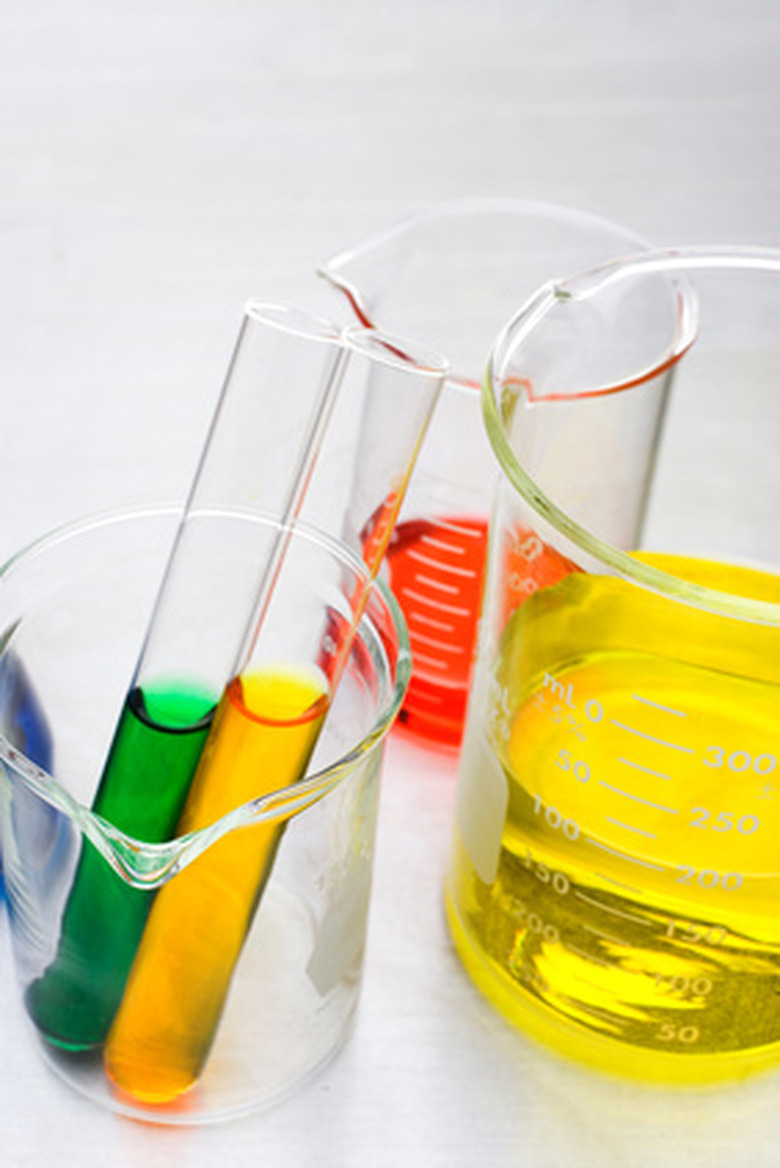How To Measure Titratable Acidity
Acids are solutions which have a higher concentration of H+ ions than OH- ions. This is measured in terms of pH. Pure water, which has an equal amount of each ion, has a pH of 7. Acids have a pH less than 7, while bases have a pH between 7 and 14. Titration is a lab procedure in which very precisely measured quantities of a chemical are added to a solution to determine something about its composition. This experiment is still possible without a precise scale and volumetric glassware, but the results will be less accurate.
Standardize the NaOH Solution
Step 1
In order to determine how acidic the mystery solution is, you will be adding NaOH, a base, drop-by-drop until the acid is neutralized. This is only helpful if you know the exact concentration of your NaOH. If you already know the exact molarity of your NaOH, skip this section. Otherwise, use your scale, which hopefully can measure to the hundredth or thousandth of a gram, and weigh out 0.5 grams of KHP. Don't worry if you can't get exactly 0.500 grams – just write down the actual weight.
Step 2
Pour the KHP into a beaker, and dissolve it in water. It doesn't matter exactly how much water you use, as long as all the KHP is dissolved.
Step 3
Set up your buret. A buret is a long glass tube, generally marked at every tenth of a milliliter, open on one end with a valve on the other. Fill the buret with your NaOH solution and place it over the KHP beaker with the bottom valve closed. Write down the volume.
Step 4
Add a few drops of your indicator, and begin titrating. Add the NaOH until you start to see blue or pink color in the beaker, depending on which indicator you used. Go very slowly from this point on, adding only a drop or two at a time and then stirring the solution. Once the color remains constant and does not fade back to clear after stirring, the titration is complete. Mark down the final volume, then subtract it from the starting volume to determine the titration volume.
Step 5
Calculate the molarity of the NaOH. At the titration endpoint, the moles of acid (KHP) are equal to the moles of base (NaOH). Calculate the moles of KHP by dividing the amount you weighed out by the molecular weight of KHP, which is 204.2212 g/mol. If you weighed 0.500 grams, this comes to 0.00245 moles. Molarity is equal to moles per liter. If you used 50 ml of NaOH, or 0.05 liters, then divide 0.00245 by 0.05 to get the molarity of the NaOH: 0.049 M.
Titration of the Unknown Sample
Step 1
You should still have plenty of fresh NaOH left over. Fill the buret again, and mark down the volume. With as much precision as your equipment allows, measure out a certain volume of your unknown sample into a beaker. Between 50 and 100 ml should work.
Step 2
Add two or three drops of indicator to the beaker, and place it under the buret. Begin titrating. You can go faster at first, swirling the beaker with one hand to mix the solution, but slow down once the color starts to appear. Add NaOH one drop at a time until the whole beaker changes color. Mark down the volume of NaOH from the buret, and subtract from the original volume.
Step 3
Calculate how many moles of NaOH you added. Simply multiply the molarity you calculated (0.049 M in the example) by the volume added from the buret. Make sure you convert to liters rather than milliliters. If, for example, you added 100 ml, the total moles added would be 0.0049. This number is equal to the number of moles of acid in your unknown solution. You can further calculate the concentration or molarity of your unknown by dividing this number by the number of liters you put in the beaker in step 1.
Things Needed
- 1 gram potassium hydrogen phthalate (KHP)
- 1 liter sodium hydroxide (NaOH)
- Buret
- Beaker
- Scale
- Acidic solution
- Indicator (Phenolphthalein or Bromothymol Blue)
TL;DR (Too Long; Didn't Read)
For extra precision, perform the standardization of NaOH titration at least three times and average the results. Do the same for the titration of your mystery sample.
Warning
Every chemical in this experiment, with the exception of the indicators, is potentially harmful. If you get any NaOH, KHP, or acid on your hands or in your eyes, rinse thoroughly under running water. Make sure to clean up any spills, because evaporation can leave a highly concentrated residue on the table.
References
Cite This Article
MLA
Moll, Eric. "How To Measure Titratable Acidity" sciencing.com, https://www.sciencing.com/measure-titratable-acidity-7285064/. 24 April 2017.
APA
Moll, Eric. (2017, April 24). How To Measure Titratable Acidity. sciencing.com. Retrieved from https://www.sciencing.com/measure-titratable-acidity-7285064/
Chicago
Moll, Eric. How To Measure Titratable Acidity last modified March 24, 2022. https://www.sciencing.com/measure-titratable-acidity-7285064/
